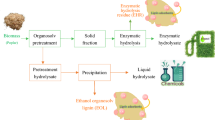Abstract
Cellulose-based material has been increasingly used as a suitable substrate for depositing metal–organic frameworks (MOFs) in recent years. In this work, MOFs (Cu-BTC) were deposited onto carboxymethylated filter paper (CMP) using four different preparation procedures: one-pot, two-step, layer-by-layer-organic (LbL-org), and layer-by-layer-water-organic (LbL-wtr-org). The products (Cu-BTC@CMP) were comparatively characterized by SEM, ATR FT-IR, XRD, and BET specific surface area analyses. The Cu-BTC crystals were immobilized on the CMP surface, where different deposit ratios (1.31% for one-pot, 4.23% for two-step, 31.49% for LbL-org, and 39.38% for LbL-wtr-org, respectively) were obtained when different preparation procedures were used under the precondition of the same chemical dosage and reaction time. The Cu-BTC crystals were found to grow in the main solution rather than on the substrate surface and the layer-by-layer method would contribute to a remarkable quantity of MOFs depositing onto the substrate surface. The crystals on Cu-BTC@CMP surface prepared by LbL-wtr-org procedure presented a much larger particle size and rougher surface compared to those prepared by the LbL-org procedure due to the aqueous solution of copper precursor. Depositing more Cu-BTC onto CMP surface also endowed the composite prepared by LbL-wtr-org procedure with the highest gas adsorption capacity (1.59 × 102 m2/g of BET specific surface area). Hence, the LbL-wtr-org procedure will be an optimal pathway for depositing metal–organic frameworks onto cellulose-based materials with the advantages of saving organic solvents and best gas adsorption ability.







Similar content being viewed by others
References
Aarne N, Kontturi E, Laine J (2012) Carboxymethyl cellulose on a fiber substrate: the interactions with cationic polyelectrolytes. Cellulose 19:2217–2231
da Silva PM, Sierra-Avila CA, Hinestroza JP (2012) In situ synthesis of a Cu-BTC metal–organic framework (MOF 199) onto cellulosic fibrous substrates: cotton. Cellulose 19:1771–1779
Duan C, Meng J, Wang X, Meng X, Sun X, Xu Y et al (2018) Synthesis of novel cellulose-based antibacterial composites of Ag nanoparticles@ metal–organic frameworks@ carboxymethylated fibers. Carbohydr Polym 193:82–88
Duan C, Meng X, Liu C, Lu W, Liu J, Dai L et al (2019) Carbohydrates-rich corncobs supported metal–organic frameworks as versatile biosorbents for dye removal and microbial inactivation. Carbohydr Polym 222:115042
Furukawa H, Cordova KE, O’Keeffe M, Yaghi OM (2013) The chemistry and applications of metal–organic frameworks. Science 341:1230444
Gholampour A, Ozbakkaloglu T (2020) A review of natural fiber composites: properties, modification and processing techniques, characterization, applications. J Mater Sci 55:829–892
Gui Z, Zhu H, Gillette E, Han X, Rubloff GW, Hu L, Lee SB (2013) Natural cellulose fiber as substrate for supercapacitor. ACS Nano 7:6037–6046
Gurunathan T, Mohanty S, Nayak SK (2015) A review of the recent developments in biocomposites based on natural fibres and their application perspectives. Compos Part A 77:1–25
He J, Kunitake T, Nakao A (2003) Facile in situ synthesis of noble metal nanoparticles in porous cellulose fibers. Chem Mater 15:4401–4406
Kim K-J, Li YJ, Kreider PB, Chang C-H, Wannenmacher N, Thallapally PK, Ahn H-G (2013) High-rate synthesis of Cu-BTC metal-organic frameworks. Chem Commun 49:11518–11520
Kim ML, Otal EH, Hinestroza JP (2019) Cellulose meets reticular chemistry: interactions between cellulosic substrates and metal–organic frameworks. Cellulose 26:123–137
Küsgens P, Siegle S, Kaskel S (2009) Crystal growth of the metal–organic framework Cu3(BTC)2 on the surface of pulp fibers. Adv Eng Mater 11:93–95
Lange LE, Obendorf SK (2015) Functionalization of cotton fiber by partial etherification and self-assembly of polyoxometalate encapsulated in Cu3(BTC)2 metal–organic framework. ACS Appl Mater Interfaces 7:3974–3980
Li Z, Hori N, Takemura A (2020) Synthesis and characterization of Cu-BTC metal–organic frameworks onto lignocellulosic fibers by layer-by-layer method in aqueous solution. Cellulose 27:1733–1744
Liu Y, Hu H (2008) X-ray diffraction study of bamboo fibers treated with NaOH. Fibers Polym 9:735–739
Ma S, Zhang M, Nie J, Yang B, Song S, Lu P (2018) Multifunctional cellulose-based air filters with high loadings of metal–organic frameworks prepared by in situ growth method for gas adsorption and antibacterial applications. Cellulose 25:5999–6010
Nan J, Dong X, Wang W, Jin W, Xu N (2011) Step-by-step seeding procedure for preparing HKUST-1 membrane on porous α-alumina support. Langmuir 27:4309–4312
Neufeld MJ, Harding JL, Reynolds MM (2015) Immobilization of metal–organic framework copper (II) benzene-1,3,5-tricarboxylate (CuBTC) onto cotton fabric as a nitric oxide release catalyst. ACS Appl Mater Interfaces 7:26742–26750
Park J, Oh M (2017) Construction of flexible metal–organic framework (MOF) papers through MOF growth on filter paper and their selective dye capture. Nanoscale 9:12850–12854
Richardson JJ, Tardy BL, Guo J et al (2019) Continuous metal–organic framework biomineralization on cellulose nanocrystals: extrusion of functional composite filaments. ACS Sustain Chem Eng 7:6287–6294
Stock N, Biswas S (2011) Synthesis of metal-organic frameworks (MOFs): routes to various MOF topologies, morphologies, and composites. Chem Rev 112:933–969
Tranchemontagne DJ, Hunt JR, Yaghi OM (2008) Room temperature synthesis of metal–organic frameworks: MOF-5, MOF-74, MOF-177, MOF-199, and IRMOF-0. Tetrahedron 64:8553–8557
Van Rie J, Thielemans W (2017) Cellulose–gold nanoparticle hybrid materials. Nanoscale 9:8525–8554
Zhang Y-Z, Wang Y, Cheng T, Lai W-Y, Pang H, Huang W (2015) Flexible supercapacitors based on paper substrates: a new paradigm for low-cost energy storage. Chem Soc Rev 44:5181–5199
Acknowledgments
Zhiqiang Li would like to thank the University of Tokyo Fellowship for international Ph.D. students. Special thanks go to Mr. Manikandan Ilangovan for polishing the writing in the manuscript revision process.
Author information
Authors and Affiliations
Corresponding author
Additional information
Publisher's Note
Springer Nature remains neutral with regard to jurisdictional claims in published maps and institutional affiliations.
Rights and permissions
About this article
Cite this article
Li, Z., Hori, N. & Takemura, A. A comparative study of depositing Cu-BTC metal–organic framework onto cellulosic filter paper via different procedures. Cellulose 27, 6537–6547 (2020). https://doi.org/10.1007/s10570-020-03229-z
Received:
Accepted:
Published:
Issue Date:
DOI: https://doi.org/10.1007/s10570-020-03229-z




